Planting a garden is an exercise in faith—the assurance of things hoped for, and the evidence of things not seen. Young children are fascinated with the phenomenon of planting a seed and watching a tiny green sprout thrust itself above the soil—the bowed necks of pole-bean sprouts making their first shy appearance still thrills me. Gardens are packed with biblical metaphor: death and resurrection especially, but also hope, toil, and blessing. Growing plants are the miracle of life made concrete and immediate, and the planting cycle has God’s imprimatur behind it: “While the earth remains, seedtime and harvest, night and day, summer and winter, shall not cease” (Gen. 8:22). So gardening will be a staple as life endures, no matter what else changes, and even if they don’t have green thumbs kids should at least get their hands dirty once in awhile. Planting is a recurring theme in children’s literature, at least since The Secret Garden. Herein are a basketful of recent children’s books on the subject: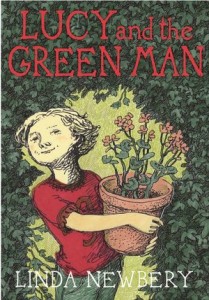
Lucy and the Green Man, by Linda Newbery. David Fickling (Random House), 2010, 218 pages. Age/interest level: 8-up.
Lucy’s Grandpa Will is known for his “green fingers,” but if asked he would give most of the credit for his magnificent garden to the Green Man, who happened by Grandpa’s country cottage outside London years ago. Recognizing a kindred spirit, the Green Man, also known as Lob, decided to stay. Only a few people can see him, and at the end of the summer that begins this book, Lucy becomes one of them—a development that holds exciting promise for the future. But that winter, Grandpa dies quite suddenly.
Lucy and Lob are dispossessed—he literally, as Lucy’s Grandma sells the property and developers bulldoze the garden and cut down the beautiful old ash tree. Lob takes to the road, searching for a new friend. Meanwhile while Lucy begins her own journey through grief, finding comfort in her Grandpa’s Green-man stories but doubting if she really saw such a person. Lob encounters people who see him but aren’t necessarily friendly, and others who see him but don’t know how or why.
The story draws on ancient pagan traditions but in a benign way that once (as C. S. Lewis speculates) was compatible with Christianity. That’s no longer true, but the story doesn’t prompt kids to worship a life force, only to appreciate it. The Green Man is a mystery: “He’s made of wind and rain,” according to Grandpa, “And sun and hail. And light and dark. There’s fire in him, too, and earth and air. He’s made of grit and stones and stardust. And time gone and time waiting. Come to think of it, the same as all of us.” In other words, a composite of physical and spiritual, of which the more we discover the more mysterious it seems. Lucy first sees Lob’s face peering from a stone arch over the church door, a juxtaposition that may not have been inappropriate when the church was built. When he rises from an untimely death (“The grave was left as untidy as an unmade bed”) an obvious comparison is probably intended. There is a life force (see Gen. 2:7 and Ezek. 37:9-10, for example) which Lucy and the Green Man doesn’t identify. But we know Him by name. Readers can appreciate the story and the beautiful language, and give thanks where it belongs.
It could be an interesting read-aloud, accompanied by questions like these: What special powers does Lob have? How is he like Jesus, and how different? Do you think Lob would worship Jesus or be opposed to him? Why? How does Psalm 104 show God’s hands-on involvement with His creation?
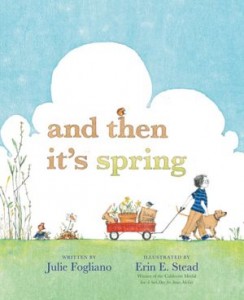 And Then It’s Spring, by Julie Fogliano, illustrated by Erin E. Stead. Roaring Brook, 2012, 32 pages. Age/interest level: 4-7.
And Then It’s Spring, by Julie Fogliano, illustrated by Erin E. Stead. Roaring Brook, 2012, 32 pages. Age/interest level: 4-7.
Some of us may remember The Carrot Seed by Ruth Krauss, about a little boy who planted a seed and persevered, even though everybody told him it wouldn’t come up. His faith was rewarded in a spectacular way when his little seed produced a carrot the size of a wheelbarrow. And Then It’s Spring takes up that theme and expands the boy’s community to include a dog, a turtle, and a rabbit, all waiting out the winter: “First you have brown, all around you have brown,” which surges to a slightly more hopeful shade of brown after the early spring rains. But what’s holding back the plants? Maybe the animals are stomping them, which leads to a warning sign : “Please do not stomp here because there are seeds and they are trying.” As we all know, spring will come, but the anticipation is lovely, as we listen for “a greenish hum” and see the animals underground busily waiting. Even little ones can appreciate the sudden, all-around green that makes young and old feel spring-y. All creation eagerly awaits the revelation of God’s sons (Rom. 8:22), and the season is a dress rehearsal.
Jo MacDonald Had a Garden, by Mary Quattlebaum, illustrated by Laura J. Bryant. Dawn Publications, 2012, 32 pages. Age/interest level: 2-6.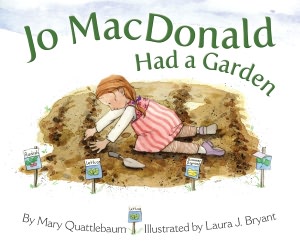
This is a read-aloud that’s also a sing-along. You guessed it—Josephine is Old MacDonald’s granddaughter, and she’s as agriculturally inclined as the old man. She begins with a little plot of ground, her cousin Mike, and lots of sunshine. Then she adds soil, worms, seeds, water—each turn of the page adds more to the mix, always with a chorus of E-I-E-I-O. Everybody knows that part, so your little ones can “read” along with you. The season ends with picking and snacking, then the garden enjoys a rest before the cycle starts over again and all the live animals and plants return. Seven of them are identified by name and character, then the reader is invited to turn back to the beginning locate the page where each one appears for the first time. An appendix includes practical gardening tips and activities, so the fun can keep growing.
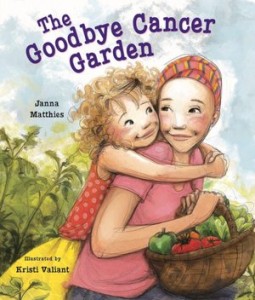 The Goodbye Cancer Garden, by Janna Mathies, illustrated by Kristi Valiant. Whitman & Company, 2011, 32 pages. Age/interest level: 4-8.
The Goodbye Cancer Garden, by Janna Mathies, illustrated by Kristi Valiant. Whitman & Company, 2011, 32 pages. Age/interest level: 4-8.
“Mom didn’t expect the doctor to say she had breast cancer. But in January, with the backyard under a blanket of snow, she and Dad told us the news.” Mom looks way too young for such a diagnosis, but so was the author, who went through this herself. After Mom’s surgery the narrator (the unnamed girl of the family) suggests a family garden as a way to work toward Mom getting batter: “Hello pumpkins, goodbye cancer.” As the months go by, they make their plans, buy their seeds, till the ground. Meanwhile Mom recovers from surgery and cuts her hair in anticipation of chemo. The months pass with summer activities, and in October—pumpkins! The garden is a lovely metaphor and the pictures, busy with black pen-strokes and watercolor smiles, are uniformly positive. Maybe too positive, for families whose stories don’t end so well. It might not be for everyone going through cancer treatment, but it shows how family solidarity, loyal friends, rhythms of nature, and fresh produce leave us a lot to be thankful for regardless. Dedicated to “everyone who walked through the valley with us, and for those who journey there now (Psalm 23).”
If these books inspire enthusiasm among your kids, your library should have some practical gardening guides just for them. Here’s one I found while browsing the stacks: Kinder Garden’s Growing Inspiration for Children, by Michael Glassman and Lisa Ely, published by Schiffer Publications in 2010. “Kinder” is a kid-size muppet who’s just discovered the joys of growing stuff after a visit to a farm: “I had no idea that fruits and vegetables grow out of the ground. I just thought somehow they magically appeared at the grocery store . . .” (I wonder how many other kids think that?) We start with the basics—sun, soil, food and water—sharing just enough about each one to give readers a good starting knowledge. They learn to draw a diagram of their potential garden space and chart where the sun falls on it during each part of the day. Then rudimentary soil-testing, compost-making and mulching, followed by a survey of the eight different classes of veggies and how they grow follows. I learned things I didn’t know, like how to plant directly in a bag of potting soil. The last chapter is fun projects, like a wagon-wheel pizza garden and found objects recycled as planters.
While you’re making plans, don’t forget the tools! Children love to have their own stuff to work with, but gardening tools should be sturdy and useable–no plastic sand shovels. Below is a link to a reasonably-priced set I bought got for my granddaughter, which has already seen the planting of many sunflower seeds.
The sun is warm, the sky is blue, the soil is ready. “While the earth remains,” let’s dig in!
One of my favorite middle-grade novels about producing a harvest is The Year Money Grew on Trees. Another novel about pagan themes embedded in English Christianity is The Perilous Gard. For more on nature symbolism, see Christ in Literature 4, and for good recommendations on nature poetry, go here.
Stay Up to Date!
Get the information you need to make wise choices about books for your children and teens.
Our weekly newsletter includes our latest reviews, related links from around the web, a featured book list, book trivia, and more. We never sell your information. You may unsubscribe at any time.
Support our writers and help keep Redeemed Reader ad-free by joining the Redeemed Reader Fellowship.
Stay Up to Date!
Get the information you need to make wise choices about books for your children and teens.
Our weekly newsletter includes our latest reviews, related links from around the web, a featured book list, book trivia, and more. We never sell your information. You may unsubscribe at any time.
We'd love to hear from you!
Our comments are now limited to our members (both Silver and Golden Key). Members, you just need to log in with your normal log-in credentials!
Not a member yet? You can join the Silver Key ($2.99/month) for a free 2-week trial. Cancel at any time. Find out more about membership here.
1 Comments
Leave a Comment
You must be logged in to post a comment.


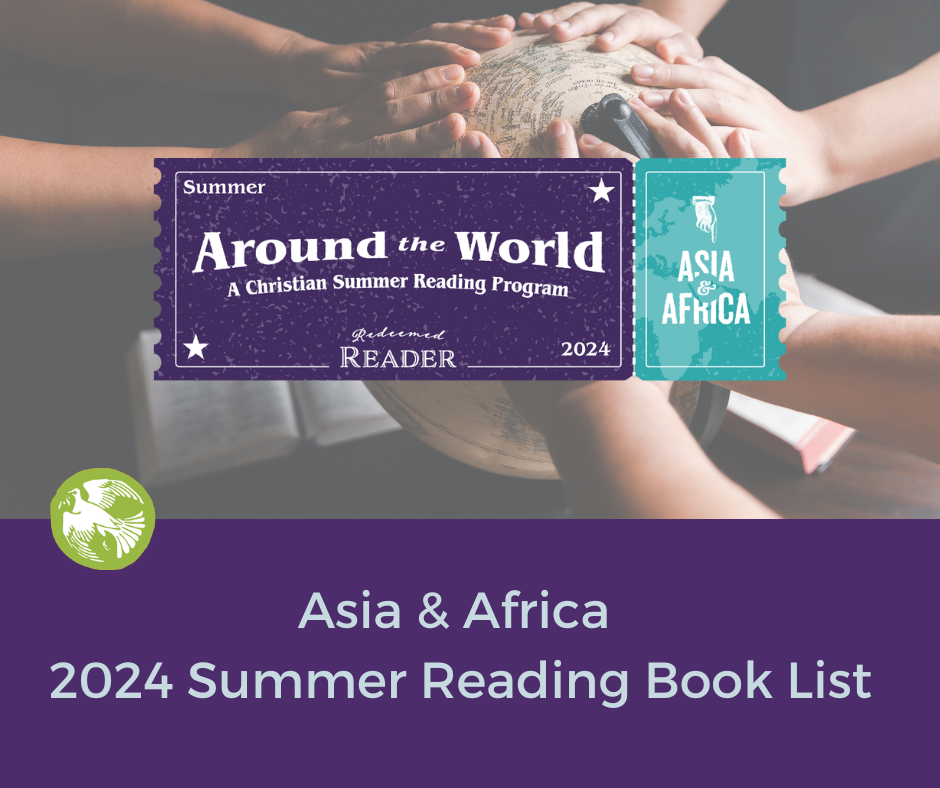

I just discovered And Then It’s Spring and loved it!! I’m going to have to check out the Green Man book–I really enjoyed The Perilous Guard.